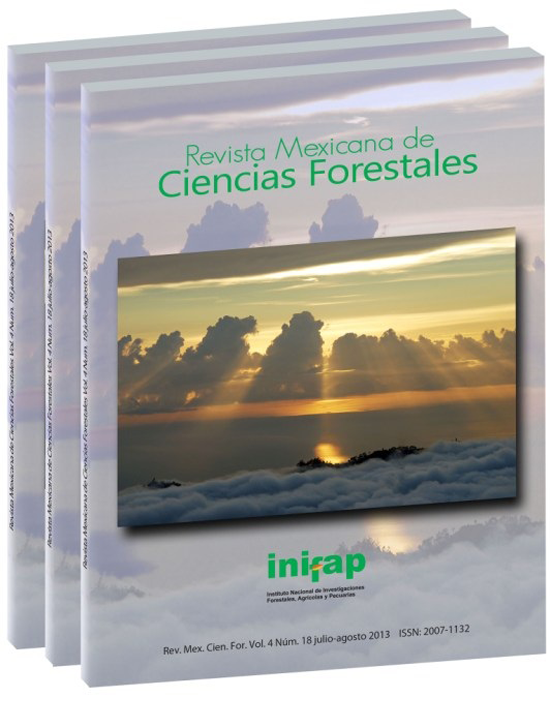ASSESSMENT OF A PLANTATION WITH TWO TROPICAL SPECIES CULTIVATED IN DIFFERENT TYPES OF CONTAINERS
DOI:
https://doi.org/10.29298/rmcf.v4i18.387Keywords:
Coconut fiber, containers, Enterolobium cyclocarpum (Jacq.) Griseb., forest plantations, plant size, Tabebuia rosea (Bertol.) DC.Abstract
The establishment of forest plantations has been promoted in order to counter deforestation in Mexico. However, these do not reach the age of harvest, since their survival rate one year after their establishment is merely 35%. The objective of this research was to assess the in-field survival and growth of Tabebuia rosea and Enterolobium cyclocarpum trees propagated in coconut fiber containers and grown in two types of compressed polystyrene trays. The plantation was established in August, 2008, in the municipality of Nuevo Urecho, Michoacán, on chromic clay soil, in a warm humid climate and at an altitude of 465 m. The experimental design was randomized blocks with six treatments and three replications; each experimental unit consisted of 25 plants, with a total of 450 plants per treatment. One year after planting, plants grown in coconut fiber containers had higher survival rates than those propagated in polystyrene trays. E. cyclocarpum showed higher rates of growth in height (231.3, 190.2 and 175.7 cm) than T. rosea (132.2, 13.4, and 95.4 cm), regardless of the type of container in which they were grown. E. cyclocarpum plants grown in coconut fiber containers achieved significantly higher growth (231.3 cm) than those cultivated in polystyrene trays. Although no significant differences were found for T. rosea trees, those grown in coconut fiber containers attained larger diameters (25.1 mm). The coconut fiber containers posed no health problems or limitations of root expansion.
Downloads
Downloads
Published
How to Cite
Issue
Section
License
The authors who publish in Revista Mexicana de Ciencias Forestales accept the following conditions:
In accordance with copyright laws, Revista Mexicana de Ciencias Forestales recognizes and respects the authors’ moral right and ownership of property rights which will be transferred to the journal for dissemination in open access.
All the texts published by Revista Mexicana de Ciencias Forestales –with no exception– are distributed under a Creative Commons License Attribution-NonCommercial 4.0 International (CC BY-NC 4.0), which allows third parties to use the publication as long as the work’s authorship and its first publication in this journal are mentioned
The author(s) can enter into independent and additional contractual agreements for the nonexclusive distribution of the version of the article published in Revista Mexicana de Ciencias Forestales (for example, include it into an institutional repository or publish it in a book) as long as it is clearly and explicitly indicated that the work was published for the first time in Revista Mexicana de Ciencias Forestales.
For all the above, the authors shall send the form of Letter-transfer of Property Rights for the first publication duly filled in and signed by the author(s). This form must be sent as a PDF file to: ciencia.forestal2@inifap.gob.mx
This work is licensed under a Creative Commons Attribution-Noncommercial 4.0 International license.






